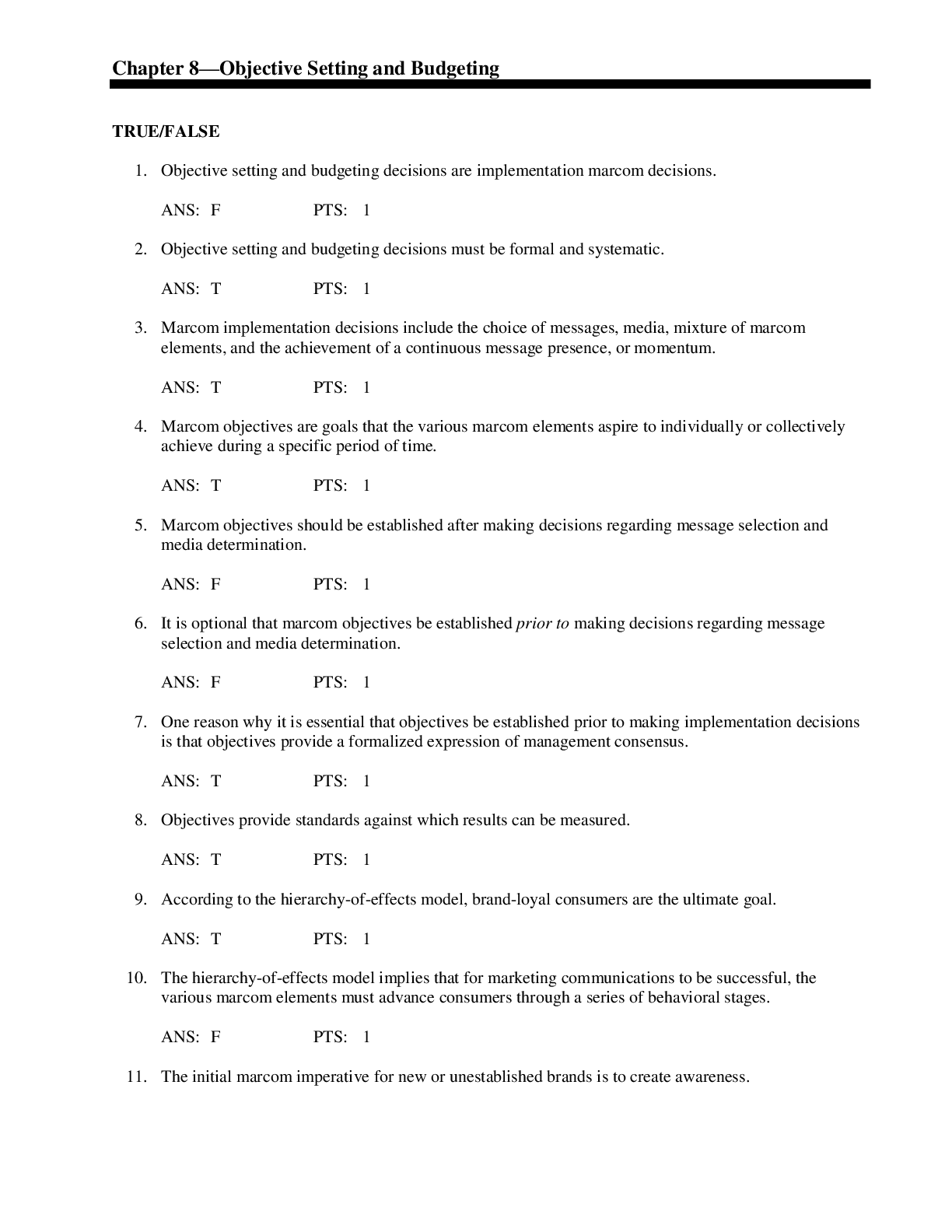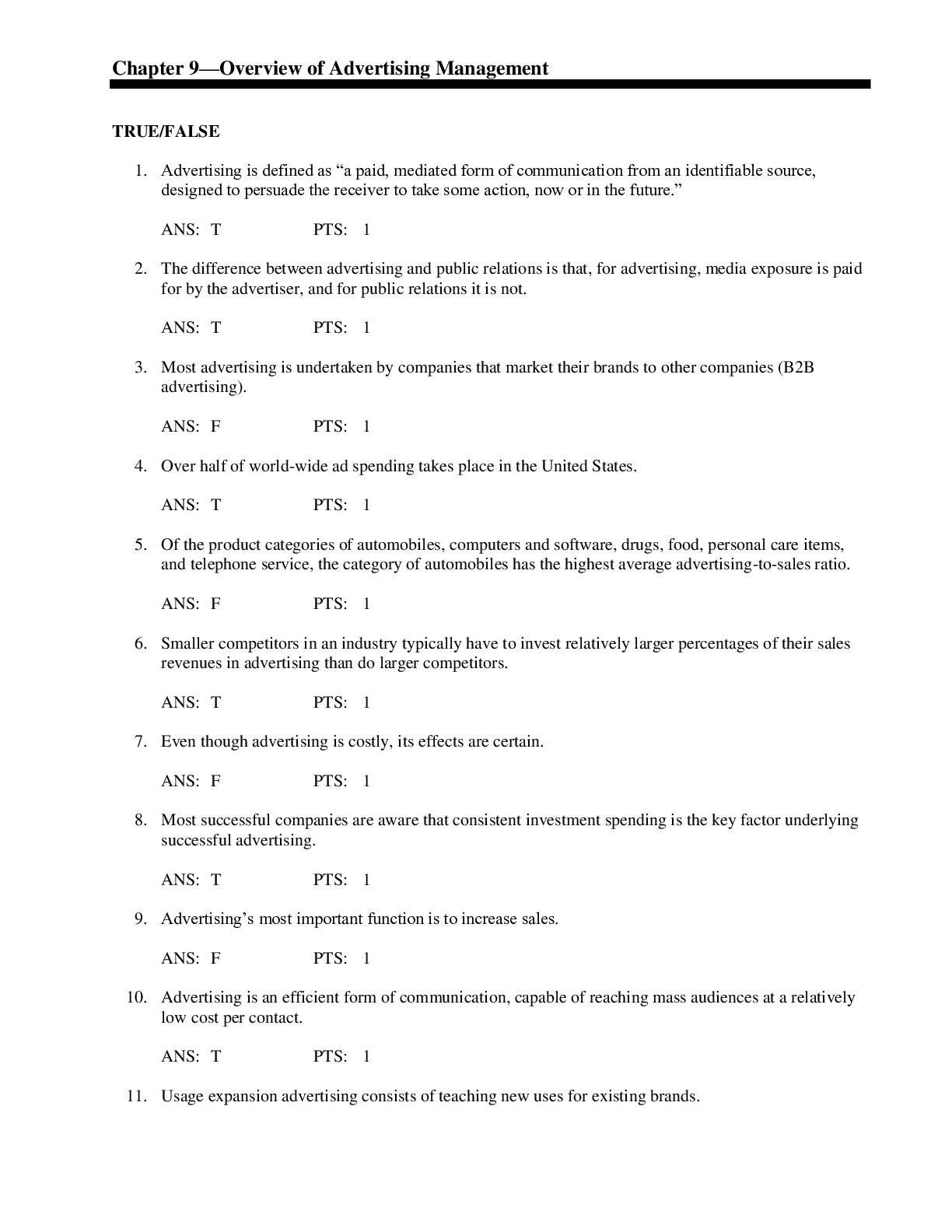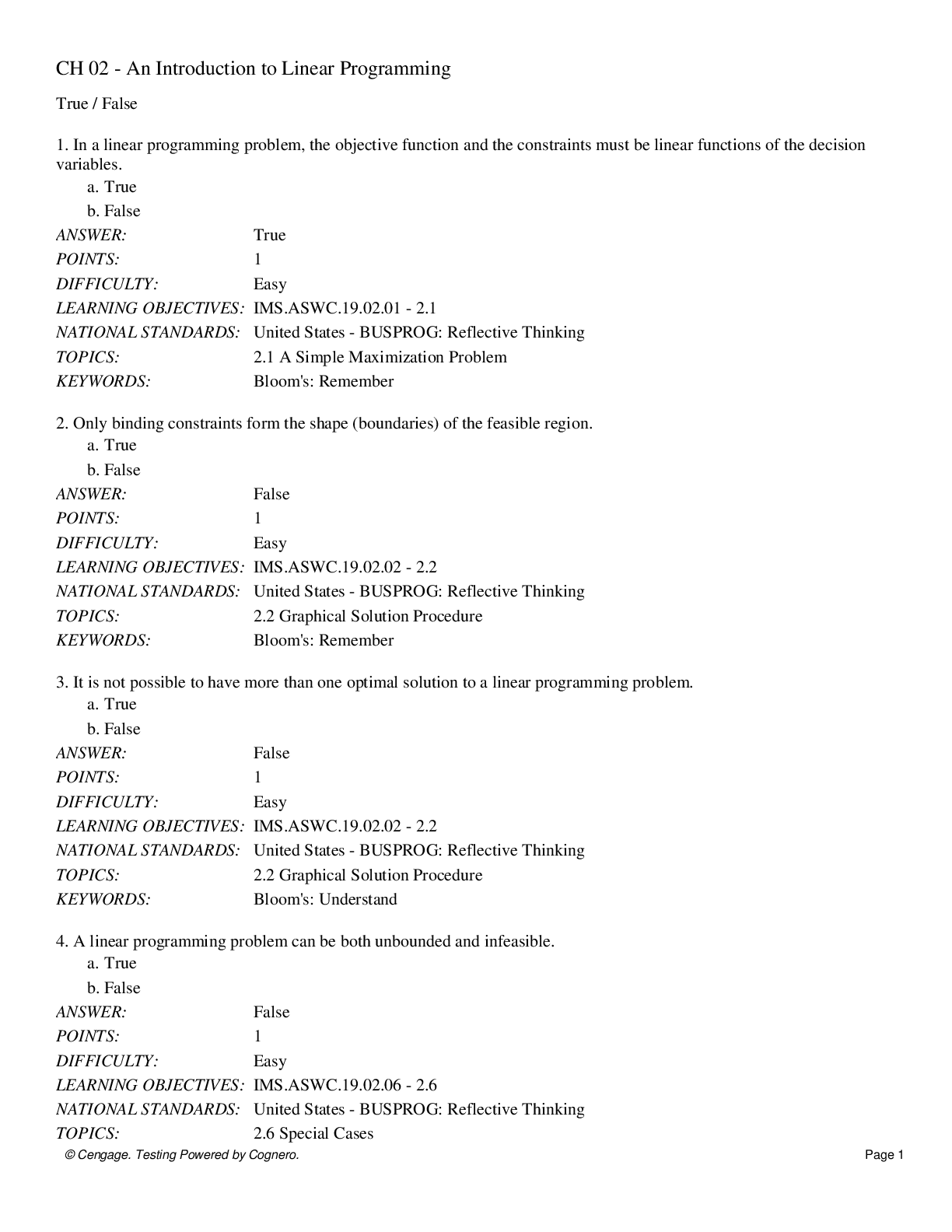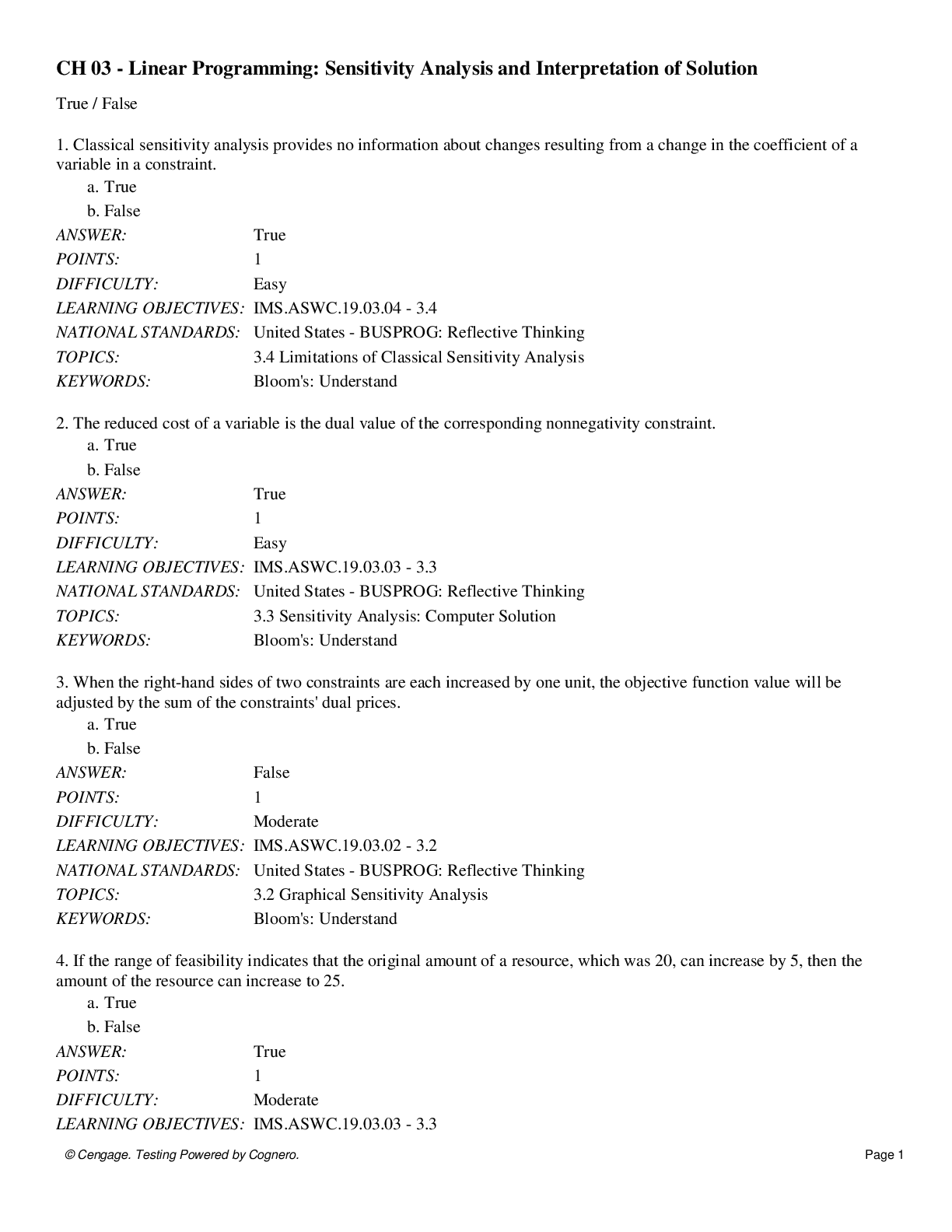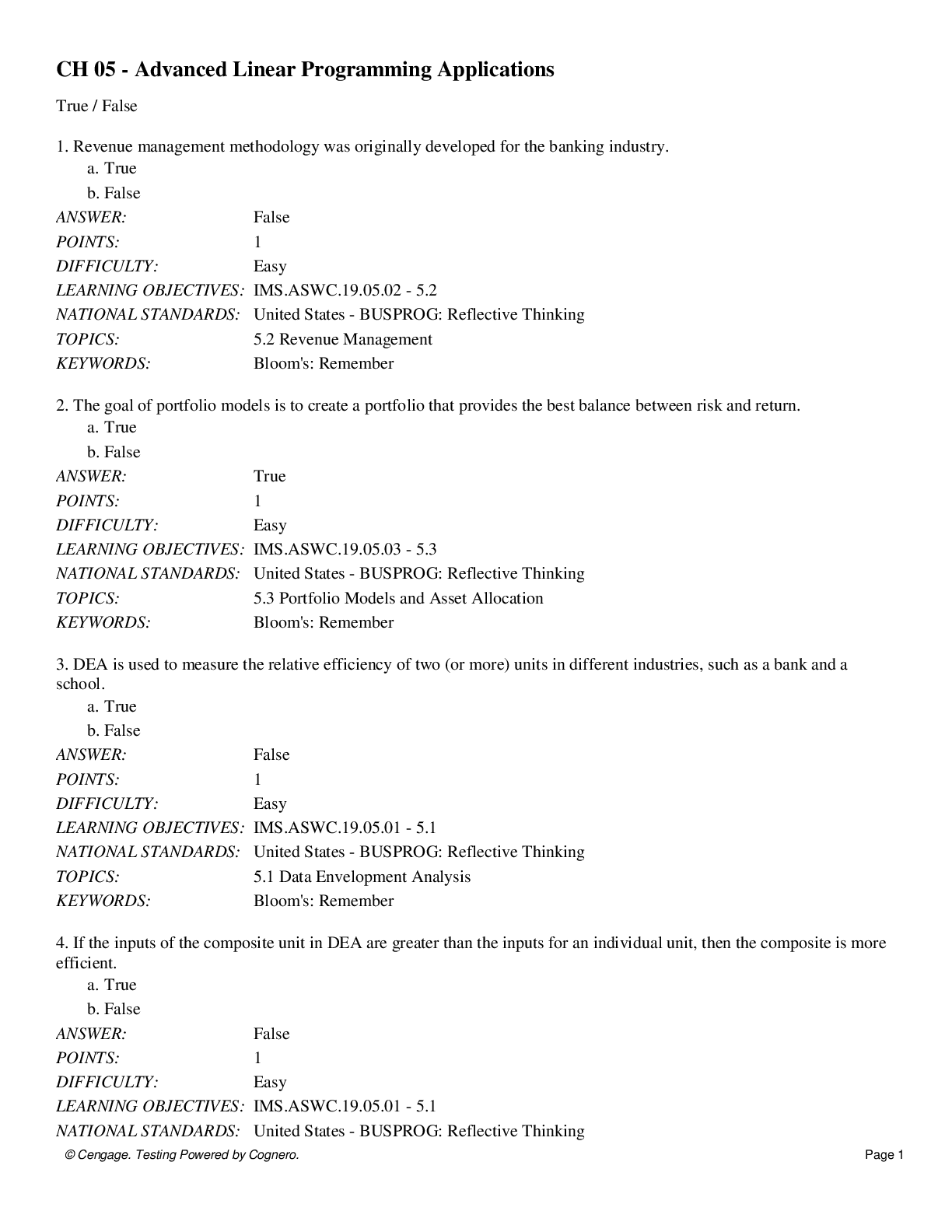*NURSING > QUESTIONS & ANSWERS > NCSBN Practice Questions and Answers Latest 2022(Full test bank, 100% verified) (All)
NCSBN Practice Questions and Answers Latest 2022(Full test bank, 100% verified)
Document Content and Description Below
NCSBN Practice Questions and Answers Latest 2022(Full test bank, 100% verified) Which individual is at greatest risk for the development of hypertension? A. 40 year-old Caucasian nurse B. 60 year-... old Asian-American shop owner C. 45 year-old African-American attorney D. 55 year-old Hispanic teacher Correct Answer- C The incidence of hypertension is greater among African-Americans than other groups in the United States. The incidence among the Hispanic population is rising. A woman, who delivered five days ago and who had been diagnosed with pregnancy induced hypertension (PIH), calls a hospital triage nurse hotline to ask for advice. She states, "I have had the worst headache for the past two days. It pounds and by the middle of the afternoon everything I look at looks wavy. Nothing I have taken helps." What should the nurse do next? A. Advise the client to have someone bring her to the emergency room as soon as possible B. Ask the client to explain what she has taken and how often, and then evaluate other specific complaints C. Advise the client that the swings in her hormones may be the problem; suggest that she call her health care provider D. Ask the client to stay on the line, get the address, and send an ambulance to the home Correct Answer- D The woman is at risk for seizure activity. The ambulance needs to bring the woman to the hospital for evaluation and treatment. For at-risk clients, PIH may progress to preeclampsia and eclampsia prior to, during, or after delivery; this may occur up to 10 days after delivery. There's a new medication order that reads: "administer 1 gtt ciprofloxacin solution OD Q 4 h" What action should the nurse take? A. Squeeze one drop of the medication in the left eye every 4 hoursB. Apply one drop in the right ear every 4 hours C. Call the prescriber to clarify and rewrite the order D. Ask other nurses for their interpretation of the order Correct Answer- C Abbreviations, symbols and dose designations can be misinterpreted and lead to medication errors. "OD" can mean "right eye" (oculus dexter) or "once daily"; it should never be used when communicating medical information. The abbreviation "Q" should be written out as "every." Although "gtt" is not on the official "Do Not Use List", it's best to use "drop" instead. Asking other nurses to interpret an order is a potentially dangerous "workaround." The nurse should call the health care provider who prescribed the medication and clarify the order. A client expresses anger when a call light is not answered within five minutes. The client demanded a blanket. How should the nurse respond? A. "I see this is frustrating for you. I have a few minutes so let's talk." B. "I am surprised that you are upset. The request could have waited a few more minutes." C. "Let's talk. Why are you upset about this?" D. "I apologize for the delay. I was involved in an emergency." Correct Answer- A This is the best response because it gives credence to the client's feelings and then concerns. To say "let's talk" and ask a why question is not a therapeutic approach because it does not acknowledge or validate the client's feelings. To apologize and not notice the client's feelings is inappropriate. To say it could have waited a few minutes is rude and non-accepting of the client's verbalized needs. The clinic nurse is assisting with medical billing. The nurse uses the DRG (Diagnosis Related Group) manual for which purpose? A. Determine reimbursement for a medical diagnosis B. Identify findings related to a medical diagnosis C. Classify nursing diagnoses from the client's health history D. Implement nursing care based on case management protocol Correct Answer- DRGs are the basis of prospective payment plans for reimbursement for Medicare clients. Other insurance companies often use it as a standard for determining payment.A nurse is planning care for a 2 year-old hospitalized child. Which issue will produce the most stress at this age? A. Fear of pain B. Separation anxiety C. Loss of control D. Bodily injury Correct Answer- B While a toddler will experience all of the stresses, separation from parents is the major stressor. Separation anxiety peaks in the toddler years. The nurse receives a client from the post anesthesia care unit following a left femoral-popliteal bypass graft procedure. Which of the following assessments requires immediate notification of the health care provider? A. Left foot is cool to the touch B. Absent left pedal pulse using Doppler analysis C. Inability to palpate the left pedal pulse D. Acute pain in the left lower leg Correct Answer- B Although the inability to palpate the left pedal pulse, a cool extremity, and increased pain in the left lower leg are important findings, they all require additional nursing assessment prior to contacting the health care provider. In clients without palpable pedal pulses, the next step in the assessment is to perform a Doppler analysis. The inability to locate the left pedal pulse using the Doppler analysis requires immediately notifying the health care provider. The nurse is reviewing the laboratory results for several clients. Which of the laboratory result indicates a client with partly compensated metabolic acidosis? A. PaCO2 30 mm Hg B. Hemoglobin 15 g/dL (150 g//L) C. Sodium 130 mEq/L (130 mmol/L) D. Chloride 100 mEq/L (100 mmol/L) Correct Answer- AMetabolic acidosis can be caused by many conditions, including renal failure, shock, severe diarrhea, dehydration, diabetic acidosis, and salicylate poisoning. With metabolic acidosis, you should expect a low pH (less than 7.35) and a low HCO3 (less than 22 mEq/L.) Compensation means the body is trying to get the pH back in balance; therefore, a pure metabolic acidosis should elicit a compensatory decrease in PaCO3 (normal is 35-45 mm Hg.) The hemoglobin is within normal limits (WNL) for both males and females. The chloride and sodium results are also WNL. A nurse is teaching a group of adults about modifiable cardiac risk factors. Which of the following should the nurse focus on first? A. Weight reduction B. Stress management C. Smoking cessation D. Physical exercise Correct Answer- C Smoking cessation is the priority for clients at risk for cardiac disease. Smoking's effects result in reduction of cell oxygenation and constriction of the blood vessels. All of the other factors should be addressed at some point in time. The client is admitted to an ambulatory surgery center and undergoes a right inguinal orchiectomy. Which option is the priority before the client can be discharged to home? A. Able to tolerate a regular diet B. Post-operative pain is managed C. Psychological counseling is scheduled D. Able to ambulate in the hallway with assistance Correct Answer- B An orchiectomy is the surgical removal of one or both testicles. It is usually performed to treat cancer (testicular, prostate or cancer of the male breast), but it may also be performed to prevent cancer (with an undescended testicle.) Due to the location of the incision, pain management is the priority. Most men will be able to eat regularly when they get home; they should at least tolerate liquids before discharge. It's important that the client is able to get up and walk with assistance, but this is not the priority. Psychological counseling may be needed as part of long-term aftercare, but this is not an immediate priority.A client is transported to the emergency department after a motor vehicle accident. When assessing the client 30 minutes after admission, the nurse notes several physical changes. Which finding would require the nurse's immediate attention? A. Increased restlessness B. Tachypnea C. Tachycardia D. Tracheal deviation Correct Answer- D Tracheal deviation is a sign that a mediastinal shift has occurred, most likely due to a tension pneumothorax. Air escaping from the injured lung into the pleural cavity causes pressure to build, collapsing the lung and shifting the mediastinum to the opposite side. This obstructs venous return to the heart, leading to circulatory instability and may result in cardiac arrest. This is a medical emergency, requiring emergency placement of a chest tube to remove air from the pleural cavity relieving the pressure. A client has a chest tube inserted immediately after surgery for a left lower lobectomy. During the repositioning of the client during the first postop check, the nurse notices 75 mL of a dark, red fluid flowing into the collection chamber of the chest drain system. What is the appropriate nursing action? A. Continue to monitor the rate of drainage B. Call the surgeon immediately C. Check to see if the client has a type and cross match D. Turn the client back to the original position Correct Answer- A It is not unusual for blood to collect in the chest and be released into the chest drain when the client changes position this soon after surgery. The dark color of the blood indicates it is not active bleeding inside of the chest. Sanguinous drainage should be expected within the initial 24 hours postop, progressing to serosanguinous and then to a serous type. If the drainage exceeds 100 mL/hr, the nurse should call the surgeon. The client with a T-2 spinal cord injury reports having a "pounding" headache. Further assessment by the nurse reveals excessive sweating, rash, pilomotor erection, facial flushing, congested nasal passages and a heart rate of 50. What action should the nurse take next? A. Assist client with relaxation techniquesB. Measure the client's respirations, blood pressure, temperature and pupillary responses C. Check the client for bladder distention and the urinary catheter for kinks D. Place the client into the bed and administer the ordered PRN analgesic Correct Answer- C These are findings of autonomic dysreflexia, also called hyperreflexia. This response occurs in clients with a spinal cord injury above the T-6 level. It is typically initiated by any noxious stimulus below the level of injury such as a full bladder, an enema or bowel movement, fecal impaction, uterine contractions, changing of the catheter and vaginal or rectal examinations. The stimulus creates an exaggerated response of the sympathetic nervous system and can be a life-threatening event. The BP is typically extremely high. The priority action of the nurse is to identify and relieve the cause of the stimulus. A child is treated with succimer for lead poisoning. Which of these assessments should the nurse perform first? A. Check serum potassium level B. Check blood calcium level C. Test deep tendon reflexes D. Check complete blood count (CBC) with differential Correct Answer- D Succimer (Chemet) is used in the management of lead or other heavy metal poisoning. Although it has generally well tolerated and has a relatively low toxicity, it may cause neutropenia. Therapy should be withheld or discontinued if the absolute neutrophil count (ANC) is below 1200/µ. A client with a diagnosis of methicillin-resistant Staphylococcus aureus (MRSA) has died. Which type of precautions is appropriate to use when performing postmortem care? A. Contact precautions B. Droplet precautions C. Compromised host precautions D. Airborne precautions Correct Answer- A The resistant bacteria remain alive for up to three days after the client dies. Therefore, contact precautions must still be used. The body should also be labeled as MRSA-contaminated so that the funeral home staff can protect themselves as well. Gown and gloves are required.The client is diagnosed with cystic fibrosis (CF). The nurse would expect the client to be treated with oral pancreatic enzymes and which type of diet? A. High fat, high-calorie B. Gluten-free, low fiber C. Dairy-free D. Sodium-restricted Correct Answer- A CF affects the cells that produce mucus, sweat and digestive juices. Someone with CF needs a highenergy diet that includes high-fat and high-calorie foods, extra fiber to prevent intestinal blockage and extra salt (especially during hot weather.) People with CF are at risk for osteoporosis and need calcium and dairy products. Someone with celiac disease or with a gluten intolerance, not CF, needs a glutenfree diet. The nurse is assessing a 4 year-old child who is in skeletal traction 24 hours after surgical repair of a fractured femur. The child is crying and reports having severe pain. The right foot is pale and there is no palpable pulse. What action should the nurse take first? A. Notify the health care provider B. Administer the ordered PRN medication C. Reassess the extremity in 15 minutes D. Readjust the traction for comfort Correct Answer- A Pain and absence of a pulse within 48-72 hours after a severe injury to an extremity suggests acute compartment syndrome. This condition occurs when there's a build up of pressure within the muscles; this pressure decreases blood flow and can cause muscle and nerve damage. Acute compartment syndrome is a medical emergency. Surgery is needed immediately; delaying surgery can lead to permanent damage to the extremity. A 67 year-old client is admitted with substernal chest pressure that radiates to the jaw. The admitting diagnosis is acute myocardial infarction (MI). What should be the priority nursing diagnosis for this client during the first 24 hours? A. Altered tissue perfusion B. Activity intoleranceC. Anxiety D. Risk for fluid volume excess Correct Answer- A In the immediate post MI period, altered tissue perfusion is priority, as an area of myocardial tissue has been damaged by a lack of blood flow and oxygenation. Interventions should be directed toward promoting tissue perfusion and oxygenation. The other problems are also relevant, but tissue perfusion is the priority. The nurse is examining a 2 year-old child with a tentative diagnosis of Wilm's tumor. The nurse would be most concerned about which statement by the mother? A. "Urinary output seems to be less over the past two days." B. "The child prefers some salty foods more than others." C. "My child has lost three pounds in the last month." D. "All the pants have become tight around the waist." Correct Answer- A Wilm's tumor is a malignant tumor of the kidney that can lead to kidney dysfunction; therefore, a recent decrease in urinary output should be investigated further as it may be a sign of renal dysfunction. Increasing abdominal girth is a common finding in Wilm's tumor, but does not require immediate intervention by the nurse. An external disaster has occurred in the town. The triage nurse from the emergency department is transported to the site and assigned to triage the injured. Which of these clients would the nurse tag as "to be seen last" by the providers at the scene? A. An older adult person with a open fracture of the left arm B. An infant with bilateral fractured lower legs with no active bleeding C. A teenager with small amount of bright red blood dripping out of the nose D. A middle-aged person with deep abrasions that are over 90% of the body Correct Answer- D The clients that are least likely to survive are to be tagged as the "last to be seen." Deep abrasions are usually treated as second or third degree burns because the fluid loss is great. Today's prothrombin time for a client receiving warfarin 20 seconds. The normal range listed by the lab is 10 to 14 seconds. What is an appropriate nursing action?A. Recognize that this is a therapeutic level B. Assess for bleeding gums or IV sites C. Notify the health care provider immediately D. Observe the client for hematoma development Correct Answer- A For the client on warfarin therapy, this prothrombin level is within the therapeutic range. Therapeutic levels for warfarin are usually 1 1/2 to 2 times the normal levels. The nurse is teaching the client with chronic renal failure (CRF) about medications. The client questions the purpose of taking aluminum hydroxide. What is the best explanation for the nurse to give the client about the therapeutic effects of this medication? A. Amphojel increases urine output B. It decreases serum phosphate C. The drug is taken to control gastric acid secretion D. It will reduce serum calcium Correct Answer- B Aluminum binds phosphates that tend to accumulate in the client with chronic renal failure due to decreased filtration capacity of the kidney. Antacids such as Amphojel are commonly used to decrease serum phosphate. The nurse is caring for a client diagnosed with acute angina. The client is receiving an intravenous infusion of nitroglycerin. What is the priority assessment during this treatment? A. Heart rate B. Neurologic status C. Urine output D. Blood pressure Correct Answer- D The vasodilatation that occurs as a result of this medication can cause profound hypotension. The client's blood pressure must be evaluated every 15 minutes until stable, and then every 30 minutes to every hour thereafter. Clients receiving IV nitroglycerin also require continuous ECG monitoring. The nurse is caring for a client in the late stages of amyotrophic lateral sclerosis (ALS). Which finding would the nurse expect?A. Confusion B. Loss of half of visual field C. Tonic-clonic seizures D. Shallow respirations Correct Answer- D ALS is a chronic progressive neurodegenerative disease that affects nerve cells in the brain and spinal cord. In ALS, upper and lower motor neurons degenerate (die) and stop sending messages to muscles; all muscles under voluntary control eventually weaken and atrophy. People eventually lose their ability to speak, eat, move and breathe. However, ALS does not impair a person's mind or intelligence. ALS does not affect a person's ability to see, smell, taste, hear or recognize touch. During assessment of orthostatic vital signs on a client with cardiomyopathy, the nurse finds that the systolic blood pressure (BP) decreased from 145 to 110 mm Hg between the supine and upright positions while the heart rate (HR) rose from 72 to 96 beats per minute. In addition, the client reports feeling lightheaded when standing up. The nurse should implement which of the following actions? A. Increase fluids that are high in protein B. Instruct client to increase fluid intake for several hours C. Instruct the client to increase fluid intake for the next two days D. Restrict fluids for the next few hours Correct Answer- B This client is experiencing postural hypotension, a decrease in systolic blood pressure 15 mm Hg accompanied by an increase in heart rate 15 to 20 beats above the baseline with a change in position from supine to upright. This is often accompanied by lightheadedness. Fluid replacement is appropriate, but must be instituted very cautiously, as this client with cardiomyopathy will also be very sensitive to changes in fluid status and fluid overload may develop rapidly with aggressive rehydration. After the client increases fluid intake for one to two hours, the client should be reassessed for resolution of the postural hypotension. The client, who is receiving chemotherapy through a central venous access device (CVAD) at home, is admitted to the intensive care unity (ICU) with a diagnosis of sepsi [Show More]
Last updated: 1 year ago
Preview 1 out of 59 pages
Instant download

Buy this document to get the full access instantly
Instant Download Access after purchase
Add to cartInstant download
Also available in bundle (1)

NCSBN NCLEX FULL SOLUTION PACK(Bundled exams and study guides with complete solution)
All Examinable Exam Questions, All You need to know.
By bundleHub Solution guider 1 year ago
$18
4
Reviews( 0 )
Document information
Connected school, study & course
About the document
Uploaded On
Sep 02, 2022
Number of pages
59
Written in
Additional information
This document has been written for:
Uploaded
Sep 02, 2022
Downloads
0
Views
79
















